IASB & IFRS: Benefits, Global Reporting Standards, and Evaluation
VerifiedAdded on 2023/05/30
|9
|2893
|134
Essay
AI Summary
This essay discusses the benefits of the International Accounting Standards Board (IASB) and the International Financial Reporting Standards (IFRS) in the context of global financial reporting. It highlights how IFRS facilitates international capital flow, promotes a globalized orientation, and offers a generalized standard-setting approach. The essay also addresses the ease of comparison, flexibility, and benefits for small investors that IFRS provides. Furthermore, it examines the differences and importance of financial reporting across different countries, touching on country attributes and measures in financial reporting. Lastly, the essay evaluates financial reporting and auditing models, emphasizing the evolution of financial statement disclosures to meet the changing needs of end-users and ensure transparency.

BENEFITS OF INTERNATIONAL ACCOUNTING STANDARD BOARD
The board or IASB provide different accounting standards so that the
accounting of different entity is done within the parameter of that accounting
standard and is accepted globally all over. Many countries have started
following international accounting standard but not in united states as of
October 2013.The Security and Exchange commission require the listed
company of US to use the GAAP principles .But the privately held companies
are not required to comply with those principles as they do not come under
the regulation of security and exchange commission .Privately owned
companies comply with the standard according to their requirement. Few
points have been highlighted below which shows the benefit of international
accounting standard:
A. Improvisation in the flow of capital: IFRS make it easier for the
company in reporting purpose. Through IFRS the accounting practice,
also become convergent and transparent. This also helps in boost of
capital across globe. It becomes very much easy for the other people
around to invest their capital in international business. Comparison of
financial statement of one business can be easily done with other
international business and it becomes very helpful and easier for the
companies to attract foreign investment, and for the investors to
decide where to park their surplus fund based on the financials of the
company.
B. Globalized Orientation: As the company is using IFRS as the
accounting standard in their books of accounts, which is accepted
globally all over the world and does not limit to a national level of
accounting. The financial statement of the company becomes easily
acceptable in those companies who comply IFRS for their reporting
purpose. The company is also not required to prepare different set of
books while bringing foreign investment in their own country; this
reduces the extra cost involved in preparing that financial statement
according to IFRS.
C. Generalized standard-setting: The requirement specified in IFRS
are very flexible and can accommodate to both expected and
unexpected changes in the international business market as they are
based on broader framework and principles. The IFRS stipulations are
The board or IASB provide different accounting standards so that the
accounting of different entity is done within the parameter of that accounting
standard and is accepted globally all over. Many countries have started
following international accounting standard but not in united states as of
October 2013.The Security and Exchange commission require the listed
company of US to use the GAAP principles .But the privately held companies
are not required to comply with those principles as they do not come under
the regulation of security and exchange commission .Privately owned
companies comply with the standard according to their requirement. Few
points have been highlighted below which shows the benefit of international
accounting standard:
A. Improvisation in the flow of capital: IFRS make it easier for the
company in reporting purpose. Through IFRS the accounting practice,
also become convergent and transparent. This also helps in boost of
capital across globe. It becomes very much easy for the other people
around to invest their capital in international business. Comparison of
financial statement of one business can be easily done with other
international business and it becomes very helpful and easier for the
companies to attract foreign investment, and for the investors to
decide where to park their surplus fund based on the financials of the
company.
B. Globalized Orientation: As the company is using IFRS as the
accounting standard in their books of accounts, which is accepted
globally all over the world and does not limit to a national level of
accounting. The financial statement of the company becomes easily
acceptable in those companies who comply IFRS for their reporting
purpose. The company is also not required to prepare different set of
books while bringing foreign investment in their own country; this
reduces the extra cost involved in preparing that financial statement
according to IFRS.
C. Generalized standard-setting: The requirement specified in IFRS
are very flexible and can accommodate to both expected and
unexpected changes in the international business market as they are
based on broader framework and principles. The IFRS stipulations are
Paraphrase This Document
Need a fresh take? Get an instant paraphrase of this document with our AI Paraphraser
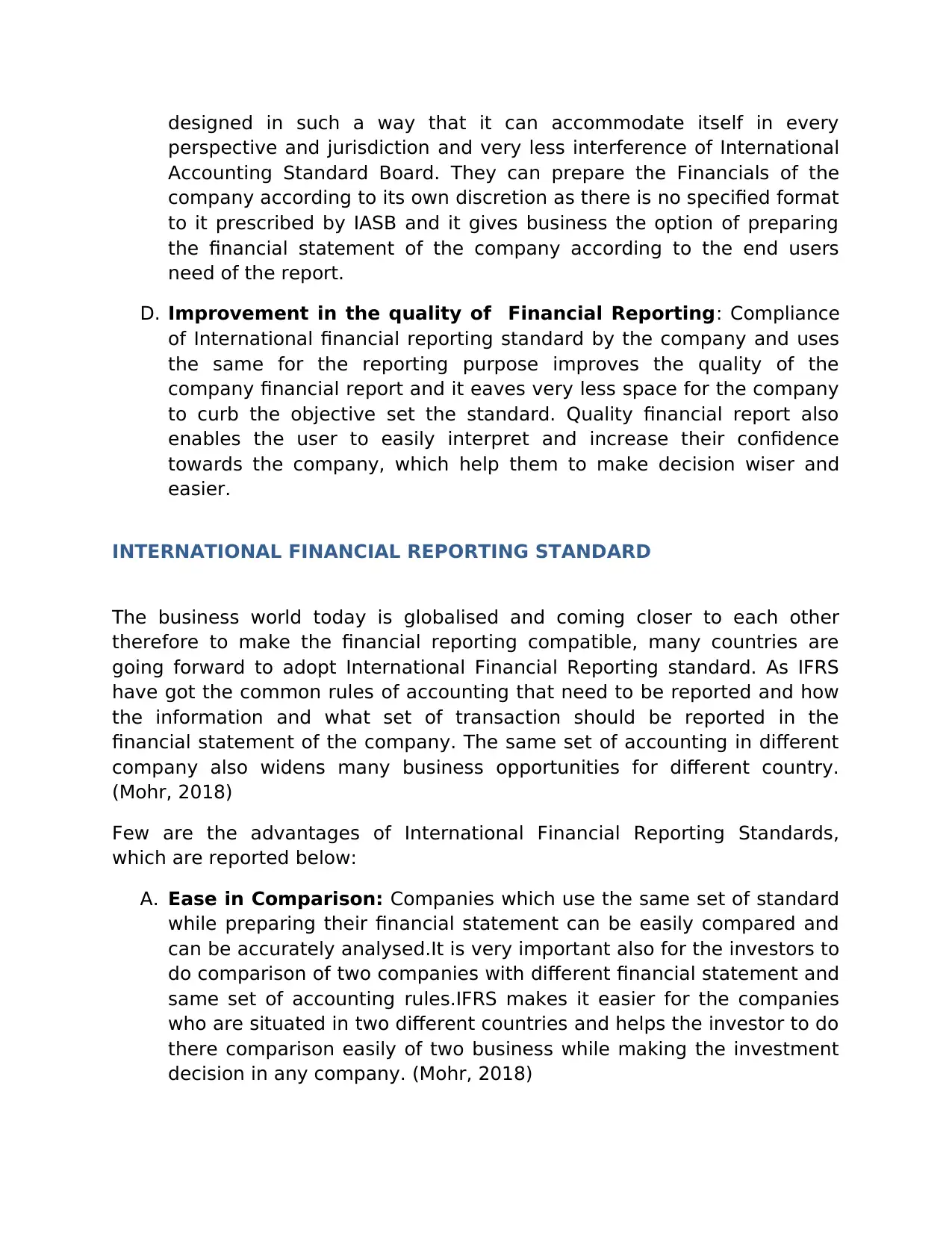
designed in such a way that it can accommodate itself in every
perspective and jurisdiction and very less interference of International
Accounting Standard Board. They can prepare the Financials of the
company according to its own discretion as there is no specified format
to it prescribed by IASB and it gives business the option of preparing
the financial statement of the company according to the end users
need of the report.
D. Improvement in the quality of Financial Reporting: Compliance
of International financial reporting standard by the company and uses
the same for the reporting purpose improves the quality of the
company financial report and it eaves very less space for the company
to curb the objective set the standard. Quality financial report also
enables the user to easily interpret and increase their confidence
towards the company, which help them to make decision wiser and
easier.
INTERNATIONAL FINANCIAL REPORTING STANDARD
The business world today is globalised and coming closer to each other
therefore to make the financial reporting compatible, many countries are
going forward to adopt International Financial Reporting standard. As IFRS
have got the common rules of accounting that need to be reported and how
the information and what set of transaction should be reported in the
financial statement of the company. The same set of accounting in different
company also widens many business opportunities for different country.
(Mohr, 2018)
Few are the advantages of International Financial Reporting Standards,
which are reported below:
A. Ease in Comparison: Companies which use the same set of standard
while preparing their financial statement can be easily compared and
can be accurately analysed.It is very important also for the investors to
do comparison of two companies with different financial statement and
same set of accounting rules.IFRS makes it easier for the companies
who are situated in two different countries and helps the investor to do
there comparison easily of two business while making the investment
decision in any company. (Mohr, 2018)
perspective and jurisdiction and very less interference of International
Accounting Standard Board. They can prepare the Financials of the
company according to its own discretion as there is no specified format
to it prescribed by IASB and it gives business the option of preparing
the financial statement of the company according to the end users
need of the report.
D. Improvement in the quality of Financial Reporting: Compliance
of International financial reporting standard by the company and uses
the same for the reporting purpose improves the quality of the
company financial report and it eaves very less space for the company
to curb the objective set the standard. Quality financial report also
enables the user to easily interpret and increase their confidence
towards the company, which help them to make decision wiser and
easier.
INTERNATIONAL FINANCIAL REPORTING STANDARD
The business world today is globalised and coming closer to each other
therefore to make the financial reporting compatible, many countries are
going forward to adopt International Financial Reporting standard. As IFRS
have got the common rules of accounting that need to be reported and how
the information and what set of transaction should be reported in the
financial statement of the company. The same set of accounting in different
company also widens many business opportunities for different country.
(Mohr, 2018)
Few are the advantages of International Financial Reporting Standards,
which are reported below:
A. Ease in Comparison: Companies which use the same set of standard
while preparing their financial statement can be easily compared and
can be accurately analysed.It is very important also for the investors to
do comparison of two companies with different financial statement and
same set of accounting rules.IFRS makes it easier for the companies
who are situated in two different countries and helps the investor to do
there comparison easily of two business while making the investment
decision in any company. (Mohr, 2018)
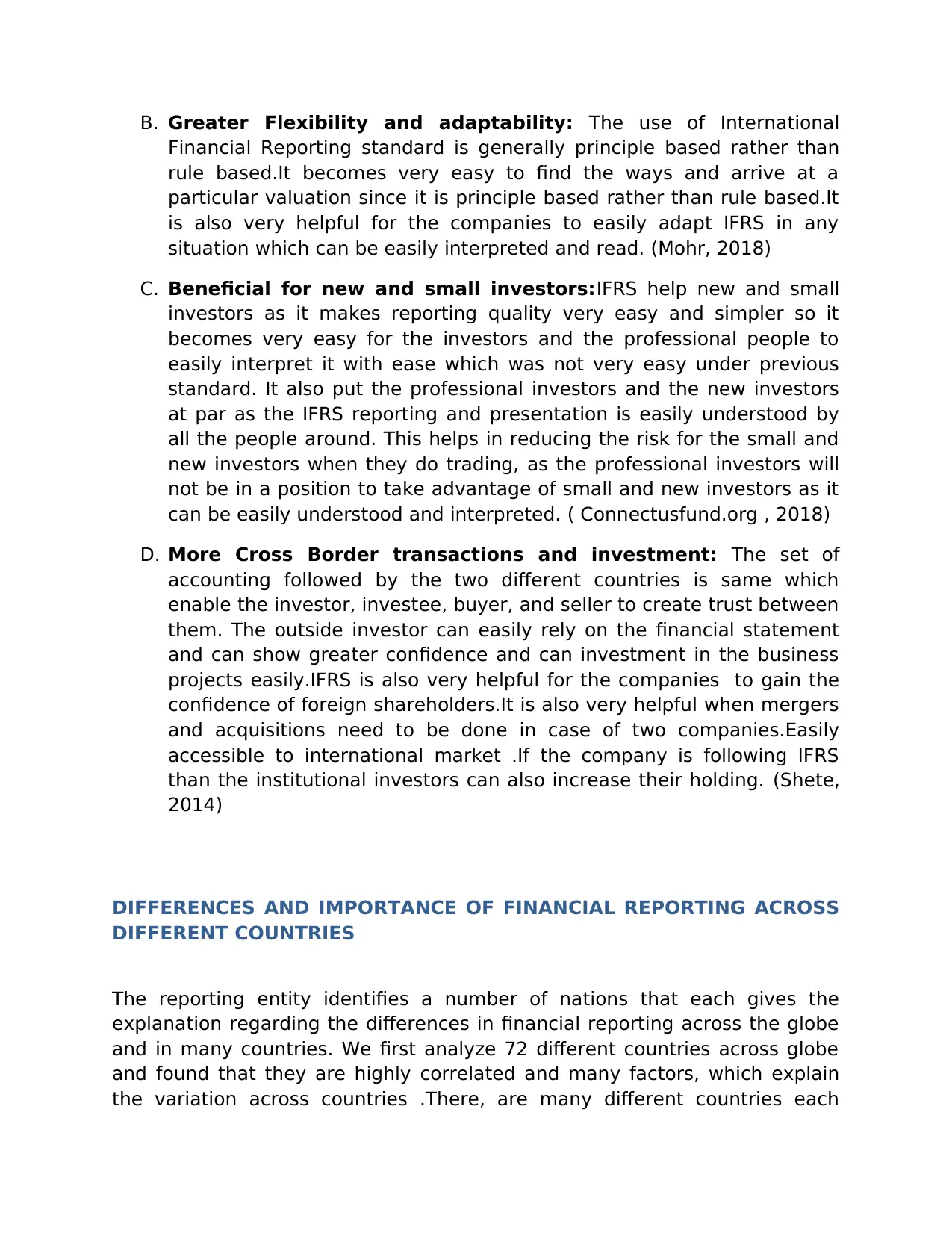
B. Greater Flexibility and adaptability: The use of International
Financial Reporting standard is generally principle based rather than
rule based.It becomes very easy to find the ways and arrive at a
particular valuation since it is principle based rather than rule based.It
is also very helpful for the companies to easily adapt IFRS in any
situation which can be easily interpreted and read. (Mohr, 2018)
C. Beneficial for new and small investors:IFRS help new and small
investors as it makes reporting quality very easy and simpler so it
becomes very easy for the investors and the professional people to
easily interpret it with ease which was not very easy under previous
standard. It also put the professional investors and the new investors
at par as the IFRS reporting and presentation is easily understood by
all the people around. This helps in reducing the risk for the small and
new investors when they do trading, as the professional investors will
not be in a position to take advantage of small and new investors as it
can be easily understood and interpreted. ( Connectusfund.org , 2018)
D. More Cross Border transactions and investment: The set of
accounting followed by the two different countries is same which
enable the investor, investee, buyer, and seller to create trust between
them. The outside investor can easily rely on the financial statement
and can show greater confidence and can investment in the business
projects easily.IFRS is also very helpful for the companies to gain the
confidence of foreign shareholders.It is also very helpful when mergers
and acquisitions need to be done in case of two companies.Easily
accessible to international market .If the company is following IFRS
than the institutional investors can also increase their holding. (Shete,
2014)
DIFFERENCES AND IMPORTANCE OF FINANCIAL REPORTING ACROSS
DIFFERENT COUNTRIES
The reporting entity identifies a number of nations that each gives the
explanation regarding the differences in financial reporting across the globe
and in many countries. We first analyze 72 different countries across globe
and found that they are highly correlated and many factors, which explain
the variation across countries .There, are many different countries each
Financial Reporting standard is generally principle based rather than
rule based.It becomes very easy to find the ways and arrive at a
particular valuation since it is principle based rather than rule based.It
is also very helpful for the companies to easily adapt IFRS in any
situation which can be easily interpreted and read. (Mohr, 2018)
C. Beneficial for new and small investors:IFRS help new and small
investors as it makes reporting quality very easy and simpler so it
becomes very easy for the investors and the professional people to
easily interpret it with ease which was not very easy under previous
standard. It also put the professional investors and the new investors
at par as the IFRS reporting and presentation is easily understood by
all the people around. This helps in reducing the risk for the small and
new investors when they do trading, as the professional investors will
not be in a position to take advantage of small and new investors as it
can be easily understood and interpreted. ( Connectusfund.org , 2018)
D. More Cross Border transactions and investment: The set of
accounting followed by the two different countries is same which
enable the investor, investee, buyer, and seller to create trust between
them. The outside investor can easily rely on the financial statement
and can show greater confidence and can investment in the business
projects easily.IFRS is also very helpful for the companies to gain the
confidence of foreign shareholders.It is also very helpful when mergers
and acquisitions need to be done in case of two companies.Easily
accessible to international market .If the company is following IFRS
than the institutional investors can also increase their holding. (Shete,
2014)
DIFFERENCES AND IMPORTANCE OF FINANCIAL REPORTING ACROSS
DIFFERENT COUNTRIES
The reporting entity identifies a number of nations that each gives the
explanation regarding the differences in financial reporting across the globe
and in many countries. We first analyze 72 different countries across globe
and found that they are highly correlated and many factors, which explain
the variation across countries .There, are many different countries each
⊘ This is a preview!⊘
Do you want full access?
Subscribe today to unlock all pages.

Trusted by 1+ million students worldwide
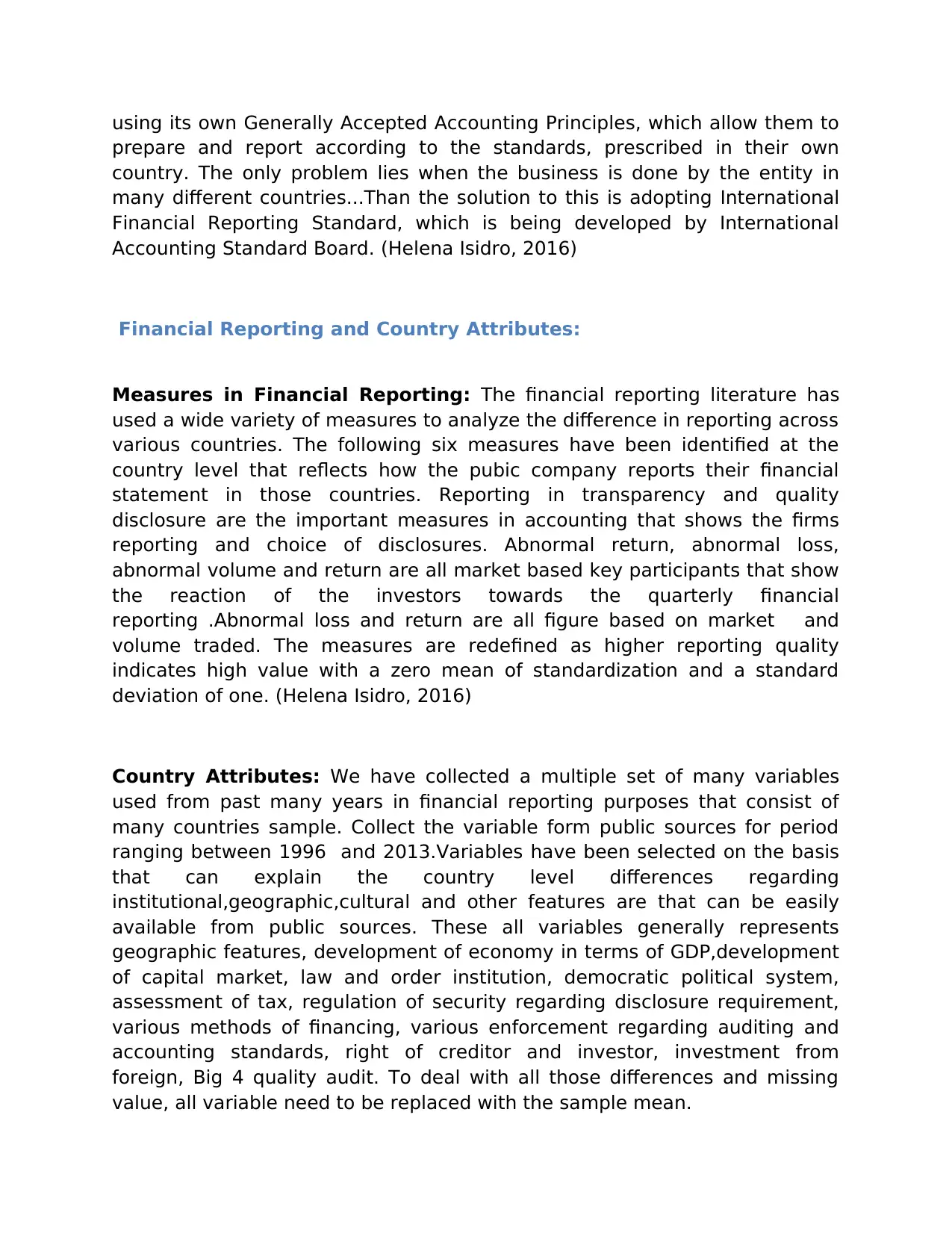
using its own Generally Accepted Accounting Principles, which allow them to
prepare and report according to the standards, prescribed in their own
country. The only problem lies when the business is done by the entity in
many different countries...Than the solution to this is adopting International
Financial Reporting Standard, which is being developed by International
Accounting Standard Board. (Helena Isidro, 2016)
Financial Reporting and Country Attributes:
Measures in Financial Reporting: The financial reporting literature has
used a wide variety of measures to analyze the difference in reporting across
various countries. The following six measures have been identified at the
country level that reflects how the pubic company reports their financial
statement in those countries. Reporting in transparency and quality
disclosure are the important measures in accounting that shows the firms
reporting and choice of disclosures. Abnormal return, abnormal loss,
abnormal volume and return are all market based key participants that show
the reaction of the investors towards the quarterly financial
reporting .Abnormal loss and return are all figure based on market and
volume traded. The measures are redefined as higher reporting quality
indicates high value with a zero mean of standardization and a standard
deviation of one. (Helena Isidro, 2016)
Country Attributes: We have collected a multiple set of many variables
used from past many years in financial reporting purposes that consist of
many countries sample. Collect the variable form public sources for period
ranging between 1996 and 2013.Variables have been selected on the basis
that can explain the country level differences regarding
institutional,geographic,cultural and other features are that can be easily
available from public sources. These all variables generally represents
geographic features, development of economy in terms of GDP,development
of capital market, law and order institution, democratic political system,
assessment of tax, regulation of security regarding disclosure requirement,
various methods of financing, various enforcement regarding auditing and
accounting standards, right of creditor and investor, investment from
foreign, Big 4 quality audit. To deal with all those differences and missing
value, all variable need to be replaced with the sample mean.
prepare and report according to the standards, prescribed in their own
country. The only problem lies when the business is done by the entity in
many different countries...Than the solution to this is adopting International
Financial Reporting Standard, which is being developed by International
Accounting Standard Board. (Helena Isidro, 2016)
Financial Reporting and Country Attributes:
Measures in Financial Reporting: The financial reporting literature has
used a wide variety of measures to analyze the difference in reporting across
various countries. The following six measures have been identified at the
country level that reflects how the pubic company reports their financial
statement in those countries. Reporting in transparency and quality
disclosure are the important measures in accounting that shows the firms
reporting and choice of disclosures. Abnormal return, abnormal loss,
abnormal volume and return are all market based key participants that show
the reaction of the investors towards the quarterly financial
reporting .Abnormal loss and return are all figure based on market and
volume traded. The measures are redefined as higher reporting quality
indicates high value with a zero mean of standardization and a standard
deviation of one. (Helena Isidro, 2016)
Country Attributes: We have collected a multiple set of many variables
used from past many years in financial reporting purposes that consist of
many countries sample. Collect the variable form public sources for period
ranging between 1996 and 2013.Variables have been selected on the basis
that can explain the country level differences regarding
institutional,geographic,cultural and other features are that can be easily
available from public sources. These all variables generally represents
geographic features, development of economy in terms of GDP,development
of capital market, law and order institution, democratic political system,
assessment of tax, regulation of security regarding disclosure requirement,
various methods of financing, various enforcement regarding auditing and
accounting standards, right of creditor and investor, investment from
foreign, Big 4 quality audit. To deal with all those differences and missing
value, all variable need to be replaced with the sample mean.
Paraphrase This Document
Need a fresh take? Get an instant paraphrase of this document with our AI Paraphraser
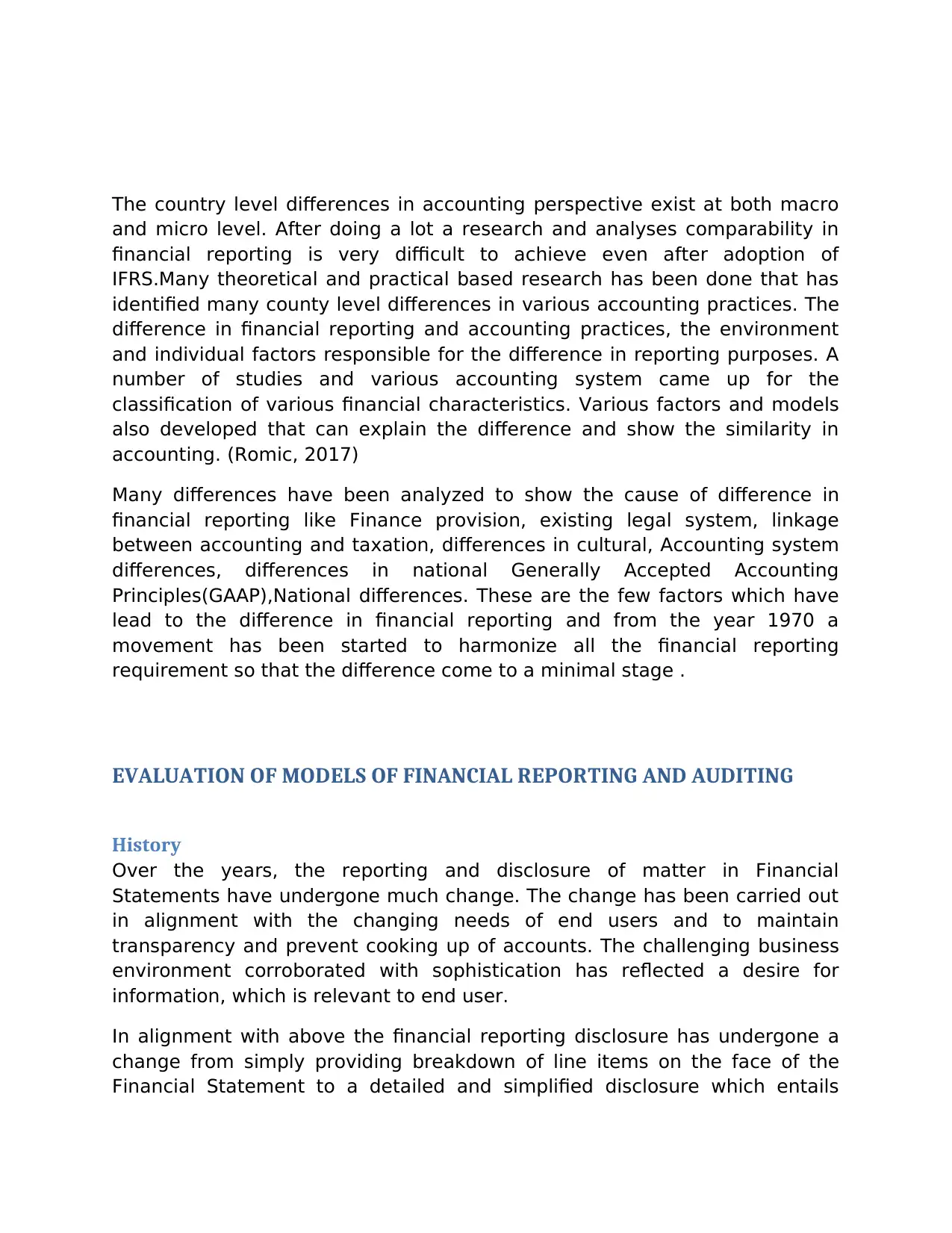
The country level differences in accounting perspective exist at both macro
and micro level. After doing a lot a research and analyses comparability in
financial reporting is very difficult to achieve even after adoption of
IFRS.Many theoretical and practical based research has been done that has
identified many county level differences in various accounting practices. The
difference in financial reporting and accounting practices, the environment
and individual factors responsible for the difference in reporting purposes. A
number of studies and various accounting system came up for the
classification of various financial characteristics. Various factors and models
also developed that can explain the difference and show the similarity in
accounting. (Romic, 2017)
Many differences have been analyzed to show the cause of difference in
financial reporting like Finance provision, existing legal system, linkage
between accounting and taxation, differences in cultural, Accounting system
differences, differences in national Generally Accepted Accounting
Principles(GAAP),National differences. These are the few factors which have
lead to the difference in financial reporting and from the year 1970 a
movement has been started to harmonize all the financial reporting
requirement so that the difference come to a minimal stage .
EVALUATION OF MODELS OF FINANCIAL REPORTING AND AUDITING
History
Over the years, the reporting and disclosure of matter in Financial
Statements have undergone much change. The change has been carried out
in alignment with the changing needs of end users and to maintain
transparency and prevent cooking up of accounts. The challenging business
environment corroborated with sophistication has reflected a desire for
information, which is relevant to end user.
In alignment with above the financial reporting disclosure has undergone a
change from simply providing breakdown of line items on the face of the
Financial Statement to a detailed and simplified disclosure which entails
and micro level. After doing a lot a research and analyses comparability in
financial reporting is very difficult to achieve even after adoption of
IFRS.Many theoretical and practical based research has been done that has
identified many county level differences in various accounting practices. The
difference in financial reporting and accounting practices, the environment
and individual factors responsible for the difference in reporting purposes. A
number of studies and various accounting system came up for the
classification of various financial characteristics. Various factors and models
also developed that can explain the difference and show the similarity in
accounting. (Romic, 2017)
Many differences have been analyzed to show the cause of difference in
financial reporting like Finance provision, existing legal system, linkage
between accounting and taxation, differences in cultural, Accounting system
differences, differences in national Generally Accepted Accounting
Principles(GAAP),National differences. These are the few factors which have
lead to the difference in financial reporting and from the year 1970 a
movement has been started to harmonize all the financial reporting
requirement so that the difference come to a minimal stage .
EVALUATION OF MODELS OF FINANCIAL REPORTING AND AUDITING
History
Over the years, the reporting and disclosure of matter in Financial
Statements have undergone much change. The change has been carried out
in alignment with the changing needs of end users and to maintain
transparency and prevent cooking up of accounts. The challenging business
environment corroborated with sophistication has reflected a desire for
information, which is relevant to end user.
In alignment with above the financial reporting disclosure has undergone a
change from simply providing breakdown of line items on the face of the
Financial Statement to a detailed and simplified disclosure which entails
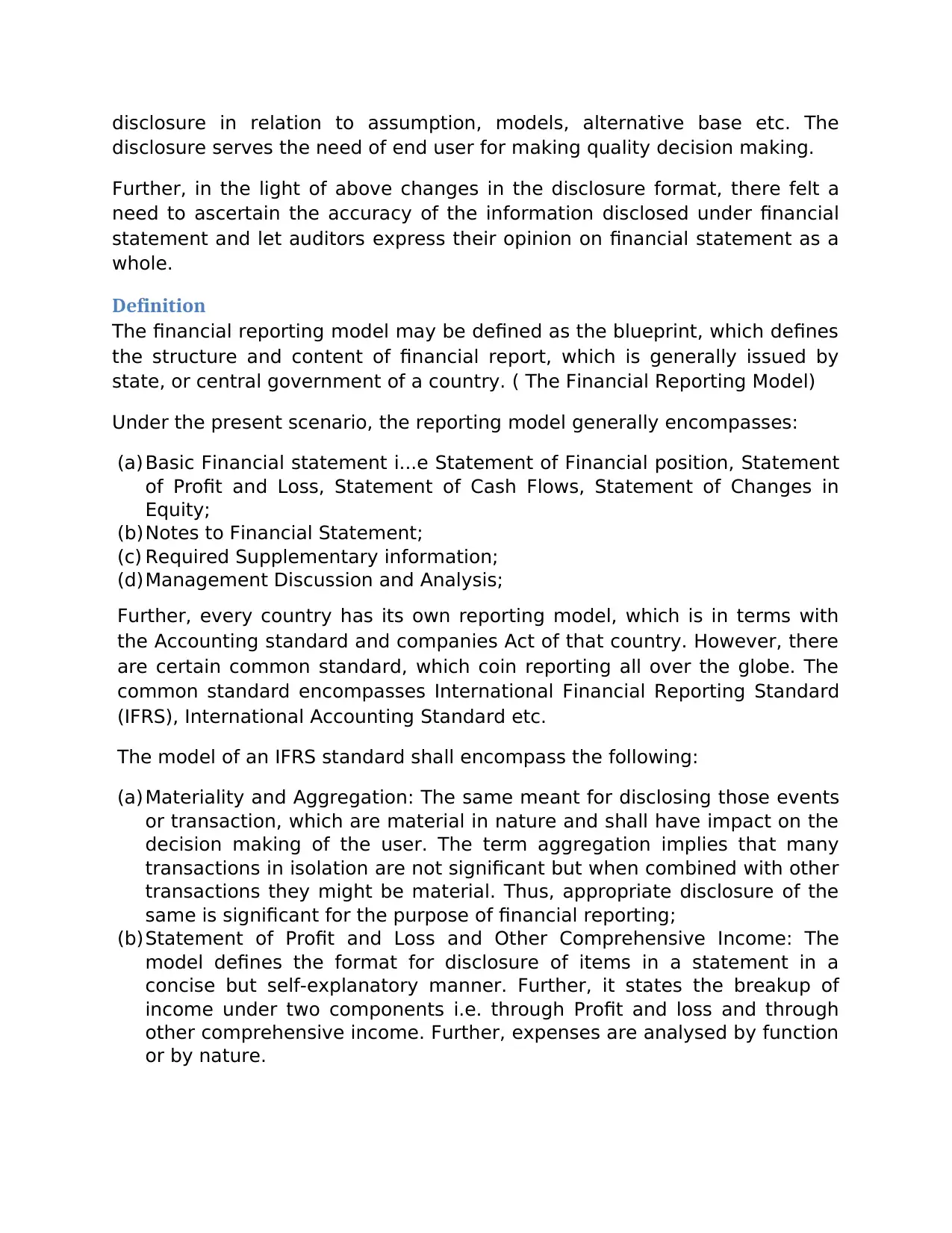
disclosure in relation to assumption, models, alternative base etc. The
disclosure serves the need of end user for making quality decision making.
Further, in the light of above changes in the disclosure format, there felt a
need to ascertain the accuracy of the information disclosed under financial
statement and let auditors express their opinion on financial statement as a
whole.
Definition
The financial reporting model may be defined as the blueprint, which defines
the structure and content of financial report, which is generally issued by
state, or central government of a country. ( The Financial Reporting Model)
Under the present scenario, the reporting model generally encompasses:
(a) Basic Financial statement i...e Statement of Financial position, Statement
of Profit and Loss, Statement of Cash Flows, Statement of Changes in
Equity;
(b)Notes to Financial Statement;
(c) Required Supplementary information;
(d)Management Discussion and Analysis;
Further, every country has its own reporting model, which is in terms with
the Accounting standard and companies Act of that country. However, there
are certain common standard, which coin reporting all over the globe. The
common standard encompasses International Financial Reporting Standard
(IFRS), International Accounting Standard etc.
The model of an IFRS standard shall encompass the following:
(a) Materiality and Aggregation: The same meant for disclosing those events
or transaction, which are material in nature and shall have impact on the
decision making of the user. The term aggregation implies that many
transactions in isolation are not significant but when combined with other
transactions they might be material. Thus, appropriate disclosure of the
same is significant for the purpose of financial reporting;
(b)Statement of Profit and Loss and Other Comprehensive Income: The
model defines the format for disclosure of items in a statement in a
concise but self-explanatory manner. Further, it states the breakup of
income under two components i.e. through Profit and loss and through
other comprehensive income. Further, expenses are analysed by function
or by nature.
disclosure serves the need of end user for making quality decision making.
Further, in the light of above changes in the disclosure format, there felt a
need to ascertain the accuracy of the information disclosed under financial
statement and let auditors express their opinion on financial statement as a
whole.
Definition
The financial reporting model may be defined as the blueprint, which defines
the structure and content of financial report, which is generally issued by
state, or central government of a country. ( The Financial Reporting Model)
Under the present scenario, the reporting model generally encompasses:
(a) Basic Financial statement i...e Statement of Financial position, Statement
of Profit and Loss, Statement of Cash Flows, Statement of Changes in
Equity;
(b)Notes to Financial Statement;
(c) Required Supplementary information;
(d)Management Discussion and Analysis;
Further, every country has its own reporting model, which is in terms with
the Accounting standard and companies Act of that country. However, there
are certain common standard, which coin reporting all over the globe. The
common standard encompasses International Financial Reporting Standard
(IFRS), International Accounting Standard etc.
The model of an IFRS standard shall encompass the following:
(a) Materiality and Aggregation: The same meant for disclosing those events
or transaction, which are material in nature and shall have impact on the
decision making of the user. The term aggregation implies that many
transactions in isolation are not significant but when combined with other
transactions they might be material. Thus, appropriate disclosure of the
same is significant for the purpose of financial reporting;
(b)Statement of Profit and Loss and Other Comprehensive Income: The
model defines the format for disclosure of items in a statement in a
concise but self-explanatory manner. Further, it states the breakup of
income under two components i.e. through Profit and loss and through
other comprehensive income. Further, expenses are analysed by function
or by nature.
⊘ This is a preview!⊘
Do you want full access?
Subscribe today to unlock all pages.

Trusted by 1+ million students worldwide
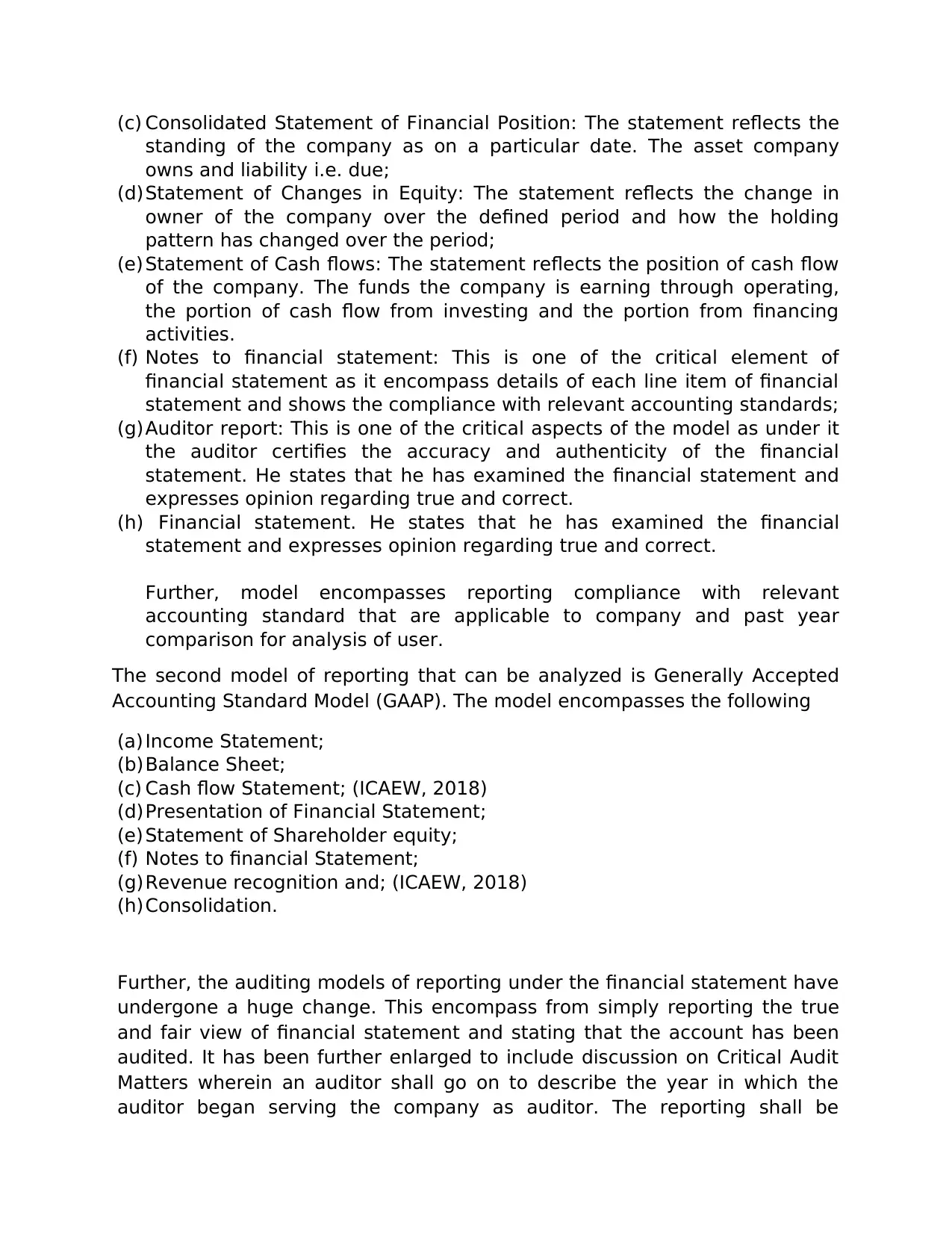
(c) Consolidated Statement of Financial Position: The statement reflects the
standing of the company as on a particular date. The asset company
owns and liability i.e. due;
(d)Statement of Changes in Equity: The statement reflects the change in
owner of the company over the defined period and how the holding
pattern has changed over the period;
(e) Statement of Cash flows: The statement reflects the position of cash flow
of the company. The funds the company is earning through operating,
the portion of cash flow from investing and the portion from financing
activities.
(f) Notes to financial statement: This is one of the critical element of
financial statement as it encompass details of each line item of financial
statement and shows the compliance with relevant accounting standards;
(g)Auditor report: This is one of the critical aspects of the model as under it
the auditor certifies the accuracy and authenticity of the financial
statement. He states that he has examined the financial statement and
expresses opinion regarding true and correct.
(h) Financial statement. He states that he has examined the financial
statement and expresses opinion regarding true and correct.
Further, model encompasses reporting compliance with relevant
accounting standard that are applicable to company and past year
comparison for analysis of user.
The second model of reporting that can be analyzed is Generally Accepted
Accounting Standard Model (GAAP). The model encompasses the following
(a) Income Statement;
(b)Balance Sheet;
(c) Cash flow Statement; (ICAEW, 2018)
(d)Presentation of Financial Statement;
(e) Statement of Shareholder equity;
(f) Notes to financial Statement;
(g)Revenue recognition and; (ICAEW, 2018)
(h)Consolidation.
Further, the auditing models of reporting under the financial statement have
undergone a huge change. This encompass from simply reporting the true
and fair view of financial statement and stating that the account has been
audited. It has been further enlarged to include discussion on Critical Audit
Matters wherein an auditor shall go on to describe the year in which the
auditor began serving the company as auditor. The reporting shall be
standing of the company as on a particular date. The asset company
owns and liability i.e. due;
(d)Statement of Changes in Equity: The statement reflects the change in
owner of the company over the defined period and how the holding
pattern has changed over the period;
(e) Statement of Cash flows: The statement reflects the position of cash flow
of the company. The funds the company is earning through operating,
the portion of cash flow from investing and the portion from financing
activities.
(f) Notes to financial statement: This is one of the critical element of
financial statement as it encompass details of each line item of financial
statement and shows the compliance with relevant accounting standards;
(g)Auditor report: This is one of the critical aspects of the model as under it
the auditor certifies the accuracy and authenticity of the financial
statement. He states that he has examined the financial statement and
expresses opinion regarding true and correct.
(h) Financial statement. He states that he has examined the financial
statement and expresses opinion regarding true and correct.
Further, model encompasses reporting compliance with relevant
accounting standard that are applicable to company and past year
comparison for analysis of user.
The second model of reporting that can be analyzed is Generally Accepted
Accounting Standard Model (GAAP). The model encompasses the following
(a) Income Statement;
(b)Balance Sheet;
(c) Cash flow Statement; (ICAEW, 2018)
(d)Presentation of Financial Statement;
(e) Statement of Shareholder equity;
(f) Notes to financial Statement;
(g)Revenue recognition and; (ICAEW, 2018)
(h)Consolidation.
Further, the auditing models of reporting under the financial statement have
undergone a huge change. This encompass from simply reporting the true
and fair view of financial statement and stating that the account has been
audited. It has been further enlarged to include discussion on Critical Audit
Matters wherein an auditor shall go on to describe the year in which the
auditor began serving the company as auditor. The reporting shall be
Paraphrase This Document
Need a fresh take? Get an instant paraphrase of this document with our AI Paraphraser
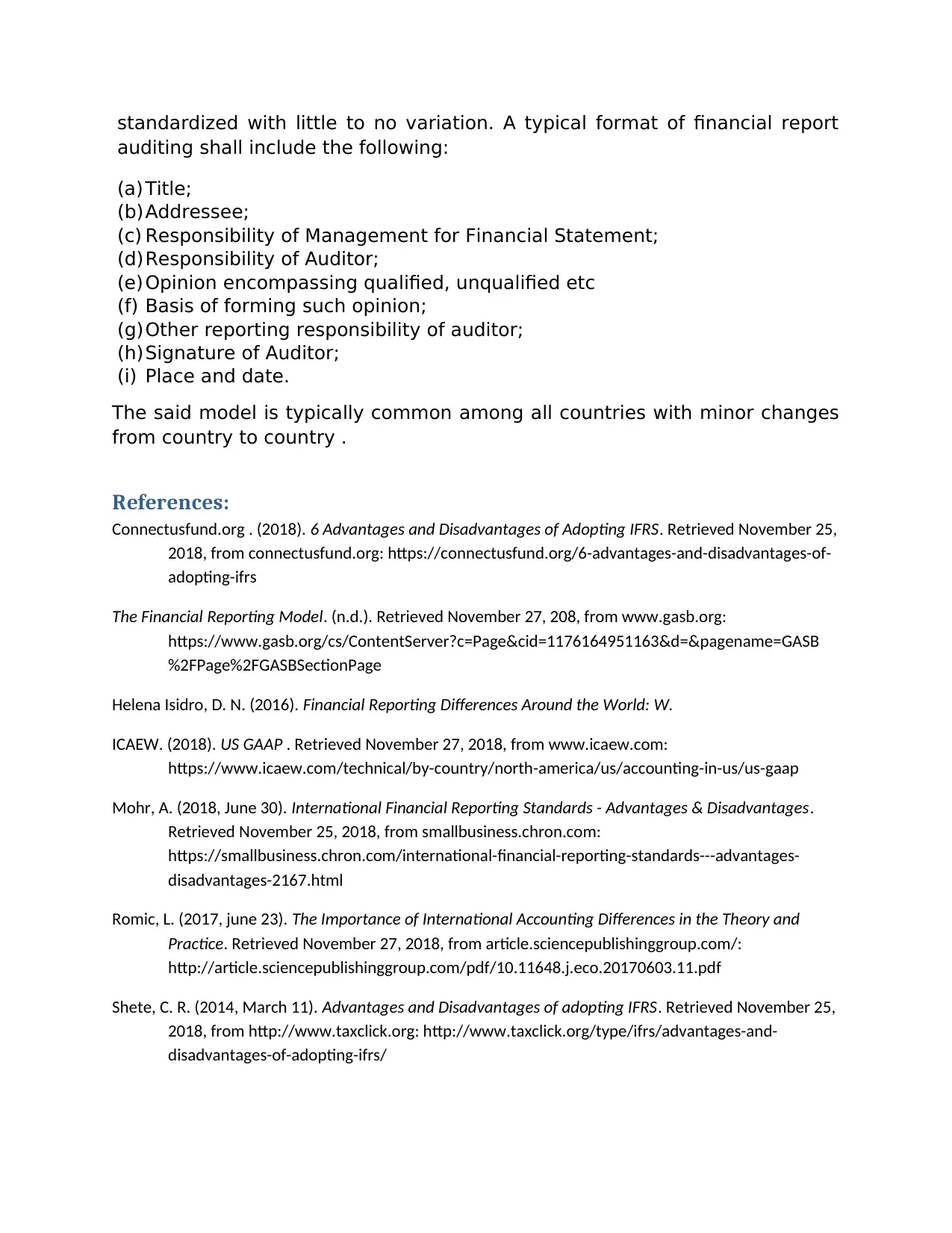
standardized with little to no variation. A typical format of financial report
auditing shall include the following:
(a) Title;
(b)Addressee;
(c) Responsibility of Management for Financial Statement;
(d)Responsibility of Auditor;
(e) Opinion encompassing qualified, unqualified etc
(f) Basis of forming such opinion;
(g)Other reporting responsibility of auditor;
(h)Signature of Auditor;
(i) Place and date.
The said model is typically common among all countries with minor changes
from country to country .
References:
Connectusfund.org . (2018). 6 Advantages and Disadvantages of Adopting IFRS. Retrieved November 25,
2018, from connectusfund.org: https://connectusfund.org/6-advantages-and-disadvantages-of-
adopting-ifrs
The Financial Reporting Model. (n.d.). Retrieved November 27, 208, from www.gasb.org:
https://www.gasb.org/cs/ContentServer?c=Page&cid=1176164951163&d=&pagename=GASB
%2FPage%2FGASBSectionPage
Helena Isidro, D. N. (2016). Financial Reporting Differences Around the World: W.
ICAEW. (2018). US GAAP . Retrieved November 27, 2018, from www.icaew.com:
https://www.icaew.com/technical/by-country/north-america/us/accounting-in-us/us-gaap
Mohr, A. (2018, June 30). International Financial Reporting Standards - Advantages & Disadvantages.
Retrieved November 25, 2018, from smallbusiness.chron.com:
https://smallbusiness.chron.com/international-financial-reporting-standards---advantages-
disadvantages-2167.html
Romic, L. (2017, june 23). The Importance of International Accounting Differences in the Theory and
Practice. Retrieved November 27, 2018, from article.sciencepublishinggroup.com/:
http://article.sciencepublishinggroup.com/pdf/10.11648.j.eco.20170603.11.pdf
Shete, C. R. (2014, March 11). Advantages and Disadvantages of adopting IFRS. Retrieved November 25,
2018, from http://www.taxclick.org: http://www.taxclick.org/type/ifrs/advantages-and-
disadvantages-of-adopting-ifrs/
auditing shall include the following:
(a) Title;
(b)Addressee;
(c) Responsibility of Management for Financial Statement;
(d)Responsibility of Auditor;
(e) Opinion encompassing qualified, unqualified etc
(f) Basis of forming such opinion;
(g)Other reporting responsibility of auditor;
(h)Signature of Auditor;
(i) Place and date.
The said model is typically common among all countries with minor changes
from country to country .
References:
Connectusfund.org . (2018). 6 Advantages and Disadvantages of Adopting IFRS. Retrieved November 25,
2018, from connectusfund.org: https://connectusfund.org/6-advantages-and-disadvantages-of-
adopting-ifrs
The Financial Reporting Model. (n.d.). Retrieved November 27, 208, from www.gasb.org:
https://www.gasb.org/cs/ContentServer?c=Page&cid=1176164951163&d=&pagename=GASB
%2FPage%2FGASBSectionPage
Helena Isidro, D. N. (2016). Financial Reporting Differences Around the World: W.
ICAEW. (2018). US GAAP . Retrieved November 27, 2018, from www.icaew.com:
https://www.icaew.com/technical/by-country/north-america/us/accounting-in-us/us-gaap
Mohr, A. (2018, June 30). International Financial Reporting Standards - Advantages & Disadvantages.
Retrieved November 25, 2018, from smallbusiness.chron.com:
https://smallbusiness.chron.com/international-financial-reporting-standards---advantages-
disadvantages-2167.html
Romic, L. (2017, june 23). The Importance of International Accounting Differences in the Theory and
Practice. Retrieved November 27, 2018, from article.sciencepublishinggroup.com/:
http://article.sciencepublishinggroup.com/pdf/10.11648.j.eco.20170603.11.pdf
Shete, C. R. (2014, March 11). Advantages and Disadvantages of adopting IFRS. Retrieved November 25,
2018, from http://www.taxclick.org: http://www.taxclick.org/type/ifrs/advantages-and-
disadvantages-of-adopting-ifrs/

⊘ This is a preview!⊘
Do you want full access?
Subscribe today to unlock all pages.

Trusted by 1+ million students worldwide
1 out of 9
Related Documents
Your All-in-One AI-Powered Toolkit for Academic Success.
+13062052269
info@desklib.com
Available 24*7 on WhatsApp / Email
![[object Object]](/_next/static/media/star-bottom.7253800d.svg)
Unlock your academic potential
Copyright © 2020–2026 A2Z Services. All Rights Reserved. Developed and managed by ZUCOL.




